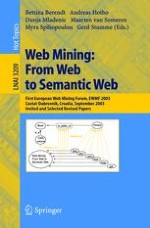In the last years, research on Web mining has reached maturity and has broadened in scope. Two different but interrelated research threads have emerged, based on the dual nature of the Web: – The Web is a practically in?nite collection of documents: The acquisition and - ploitation of information from these documents asks for intelligent techniques for information categorization, extraction and search, as well as for adaptivity to the interests and background of the organization or person that looks for information. – The Web is a venue for doing business electronically: It is a venue for interaction, information acquisition and service exploitation used by public authorities, n- governmental organizations, communities of interest and private persons. When observed as a venue for the achievement of business goals, a Web presence should be aligned to the objectives of its owner and the requirements of its users. This raises the demand for understandingWeb usage, combining it with other sources of knowledge inside an organization, and deriving lines of action. ThebirthoftheSemanticWebatthebeginningofthedecadeledtoacoercionofthetwo threadsintwoaspects:(i)theextractionofsemanticsfromtheWebtobuildtheSemantic Web;and(ii)theexploitationofthesesemanticstobettersupportinformationacquisition and to enhance the interaction for business and non-business purposes. Semantic Web mining encompasses both aspects from the viewpoint of knowledge discovery.
